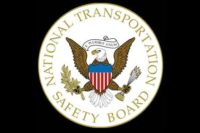A fractured fan blade. That’s what started the dangerous chain of events aboard a Southwest Airlines flight on April 17, 2018 that ended with one passenger dead and eight others injured.
The National Transportation Safety Board (NTSB) this week revealed what happened – and why - after flight 1380 departed New York’s LaGuardia Airport that day, headed for Love Field, Dallas, Texas.
The window "departed" the airplane
According to the agency, a fractured fan blade from the engine that was powering that Southwest Airlines Boeing 737-700, led to the engine inlet and fan cowl separating and subsequently damaging the fuselage, resulting in a rapid cabin depressurization. The fractured fan blade impacted the fan case, causing fan cowl fragments to strike the airplane’s fuselage near a cabin window.
In NTSB speak, the window “departed” the airplane, and the cabin rapidly depressurized.
The flight crew conducted an emergency descent and diverted to Philadelphia International Airport. There were 144 passengers and five crewmembers aboard.
A fan blade fail
“This accident demonstrates that a fan blade can fail and release differently than that observed during engine certification testing and accounted for in airframe structural analyses,” said NTSB Chairman Robert Sumwalt. “It is important to go beyond routine examination of fan blades; the structural integrity of the engine nacelle components for various airframe and engine combinations needs to be ensured.”
The NTSB noted, as part of its probable cause, the accident occurred when portions of the fan cowl separated in flight after a fan blade, which had fractured due to a fatigue crack, impacted the engine fan case at a location that was critical to the structural integrity and performance of the fan cowl structure. The NTSB found that the separated fan blade impacted the engine fan case and fractured into multiple fragments. Some of the fragments traveled forward of the engine and into the inlet. The impact of the separated fan blade with the fan case also imparted significant loads into the fan cowl through the radial restraint fitting, which is what caused the fan cowl to fail.
New safety recommendations
As a result of the investigation the NTSB issued seven new safety recommendations with five issued to the Federal Aviation Administration, one to the European Aviation Safety Agency, and one to Southwest Airlines.
These recommendations address the need to ensure the structural integrity of the fan cowl on Boeing 737 next-generation airplanes and assess whether other airframe and engine combinations have critical fan blade impact locations, the importance of having flight attendants secured in a jumpseat during emergency landings, and guidance for mitigating hazards to passengers affected by an in-flight loss of seating capacity.
An abstract of the final report, which includes the findings, probable cause, and all safety recommendations, is available at https://go.usa.gov/xp9kv.
Links to the accident docket and other publicly released information about this investigation are available at https://go.usa.gov/xpg5C.
The final report for the investigation of the accident is expected to post to the NTSB website in the next few weeks.


